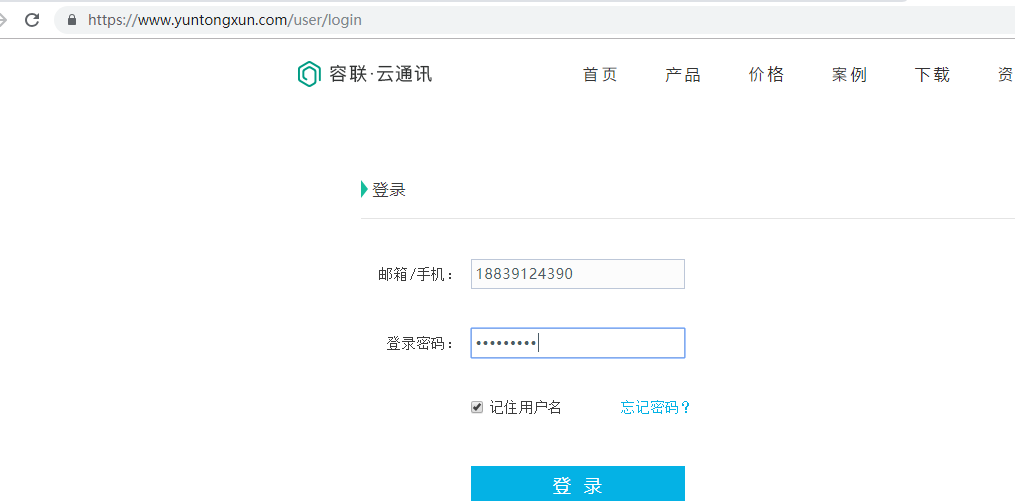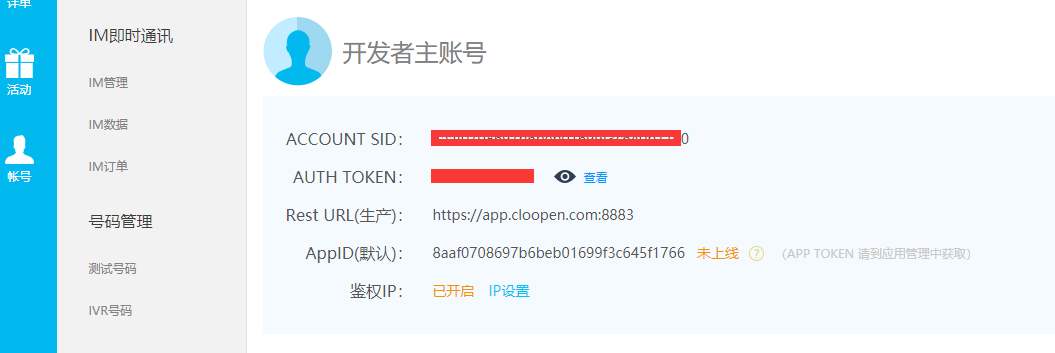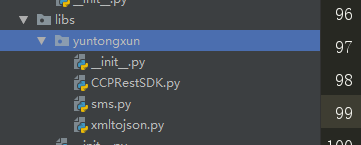vue_drf實現(xiàn)短信驗證碼
我們在做網(wǎng)站開發(fā)時,登錄頁面很多情況下是可以用手機號接收短信驗證碼,然后實現(xiàn)登錄的,那我們今天就來做一做這一功能。

偽代碼:
進(jìn)入登錄頁面,點擊短信登錄輸入手機號碼,點擊獲取驗證碼,后端在redis里保存驗證碼用戶把手機收到的驗證碼輸入,點擊登錄,會把手機號和驗證碼發(fā)往后端,然后進(jìn)行驗證
要想發(fā)送短信,讓用戶收到短信,我們的借助一個容聯(lián)云的接口,注冊一個賬號。

使用時需要的一些參數(shù):

下載sdk
1.。。。。。。。

2.。。。。。。

3.。。。。。。。

下載完成后,解壓。放入我們drf項目的apps里的libs里
二、sdk參數(shù)配置1,目錄結(jié)構(gòu)
2,配置sms.py文件
# -*- coding:utf-8 -*-from .CCPRestSDK import REST# 說明:主賬號,登陸云通訊網(wǎng)站后,可在'控制臺-應(yīng)用'中看到開發(fā)者主賬號ACCOUNT SID_accountSid = ’xxxxxxxxxxxxx’# 8a216da863f8e6c20164139687e80c1b# 說明:主賬號Token,登陸云通訊網(wǎng)站后,可在控制臺-應(yīng)用中看到開發(fā)者主賬號AUTH TOKEN_accountToken = ’xxxxxxxxxxxxx’# 6dd01b2b60104b3dbc88b2b74158bac6# 請使用管理控制臺首頁的APPID或自己創(chuàng)建應(yīng)用的APPID_appId = ’8aaf0708697b6beb01699f3c645f1766’# 8a216da863f8e6c20164139688400c21# 說明:請求地址,生產(chǎn)環(huán)境配置成app.cloopen.com_serverIP = ’sandboxapp.cloopen.com’# 說明:請求端口 ,生產(chǎn)環(huán)境為8883_serverPort = '8883'# 說明:REST API版本號保持不變_softVersion = ’2013-12-26’#下面的內(nèi)容不用修改class CCP(object): '''發(fā)送短信的輔助類''' def __new__(cls, *args, **kwargs):# 判斷是否存在類屬性_instance,_instance是類CCP的唯一對象,即單例if not hasattr(CCP, '_instance'): cls._instance = super(CCP, cls).__new__(cls, *args, **kwargs) cls._instance.rest = REST(_serverIP, _serverPort, _softVersion) cls._instance.rest.setAccount(_accountSid, _accountToken) cls._instance.rest.setAppId(_appId)return cls._instance def send_template_sms(self, to, datas, temp_id):'''發(fā)送模板短信'''# @param to 手機號碼# @param datas 內(nèi)容數(shù)據(jù) 格式為數(shù)組 例如:{’12’,’34’},如不需替換請?zhí)?’’# @param temp_id 模板Idresult = self.rest.sendTemplateSMS(to, datas, temp_id)# 如果云通訊發(fā)送短信成功,返回的字典數(shù)據(jù)result中statuCode字段的值為'000000'if result.get('statusCode') == '000000': # 返回0 表示發(fā)送短信成功 return 0else: # 返回-1 表示發(fā)送失敗 return -1if __name__ == ’__main__’: ccp = CCP() # 注意: 測試的短信模板編號為1 ccp.send_template_sms(’15914397060’, [’1234’, 5], 1)三、代碼實現(xiàn)1,后端代碼
views.py,這是獲取驗證碼請求的處理,也就是后端產(chǎn)生一個隨機碼,發(fā)送給手機用戶,然后把隨機碼存儲于redis中,然后給前端返回一個驗證碼發(fā)送成功的信號
from .models import Userfrom rest_framework import statusfrom lufei_drf.libs.yuntongxun.sms import CCPfrom django_redis import get_redis_connectionclass SMSCodeAPIView(APIView): def get(self,request):# 1. 通過查詢字符串獲取手機號碼phone = request.query_params.get('phone')ty=request.query_params.get(’type’)# 2. 發(fā)送短信之前驗證碼驗證一下手機號碼if ty==’register’: try:User.objects.get(phone=phone)return Response({'message': '當(dāng)前手機號已經(jīng)被注冊過'}, status=status.HTTP_400_BAD_REQUEST) except:passredis = get_redis_connection('sms_code')if redis.get('times_%s' % phone): return Response({'message': '當(dāng)前手機號已經(jīng)在一分鐘內(nèi)發(fā)送過短信'}, status=status.HTTP_400_BAD_REQUEST)# 3. 使用手機號碼發(fā)送短信驗證碼# 生成一個短信驗證碼sms_code = '%04d' % random.randint(0, 9999)ccp = CCP()result = ccp.send_template_sms(phone,[sms_code,'5分鐘'],1)if result == 0: # 發(fā)送短信成功,保存短信驗證碼到redis數(shù)據(jù)庫中 # 開啟管道操作 pl = redis.pipeline() pl.multi() # 接下來會在管道中執(zhí)行多條命令 # setex(變量名,有效期[秒],值 ) SMS_EXPIRE_TIME = 5 * 60 # 短信驗證碼的有效期 SMS_TIMES = 60 # 短信發(fā)送的間隔時間 # 把原來立即執(zhí)行的命令放置到管道 pl.setex('sms_%s' % phone, SMS_EXPIRE_TIME, sms_code) pl.setex('times_%s' % phone, SMS_TIMES, 1) # 統(tǒng)一執(zhí)行管道中的命令 pl.execute()# 4. 響應(yīng)數(shù)據(jù)給客戶端return Response({'message':result},status=status.HTTP_200_OK)
urls.py
from django.urls import path# jwt內(nèi)部實現(xiàn)的登陸視圖from rest_framework_jwt.views import obtain_jwt_tokenfrom .views import SMSCodeAPIView,urlpatterns=[ path(r'login/', obtain_jwt_token ), path(’sms/’,SMSCodeAPIView.as_view()),]
utils.py,這是對用戶提交手機驗證碼后,對手機號和驗證碼的校對。判斷都正確后,返回一個對象,包括token,user信息等,
from django.contrib.auth.backends import ModelBackendfrom django_redis import get_redis_connectiondef jwt_response_payload_handler(token, user=None, request=None): ''' 自定義jwt認(rèn)證成功返回數(shù)據(jù) :token 返回的jwt :user 當(dāng)前登錄的用戶信息[對象] :request 當(dāng)前本次客戶端提交過來的數(shù)據(jù) ''' return {’token’: token,’id’: user.id,’username’: user.username, }#實現(xiàn)多功能登錄import refrom .models import User#查找用戶名或手機號是否已經(jīng)是我們的用戶def get_user_by_account(account): ''' 根據(jù)帳號獲取user對象 :param account: 賬號,可以是用戶名,也可以是手機號 :return: User對象 或者 None ''' try:if re.match(’^1[3-9]d{9}$’, account): # 帳號為手機號 user = User.objects.get(phone=account)else: # 帳號為用戶名 user = User.objects.get(username=account) except User.DoesNotExist:return None else:return user#驗證用戶提交的短信和我們保存在redis里的信息是否一致def sms_code_verify(phone,sms_code): redis = get_redis_connection('sms_code') value=redis.get(’sms_%s’%phone).decode() if value==sms_code:return True return Falseclass UsernameMobileAuthBackend(ModelBackend): ''' 自定義用戶名或手機號認(rèn)證 ''' def authenticate(self, request, username=None, password=None, **kwargs):user = get_user_by_account(username)#當(dāng)密碼長度為4時,我判斷其為手機號和短信驗證碼登錄if len(password)==4 and user is not None and sms_code_verify(username,password): return userelif user is not None and user.check_password(password): return userelse: return None2,前端代碼
login組件
<template> <div id='login'> <div class='box'> <p><img src='http://m.4tl426be.cn/assets/login_title.png' alt=''> </p> <p class='sign'>幫助有志向的年輕人通過努力學(xué)習(xí)獲得體面的工作和生活!</p> <div v-show='num==1'><div class='title2 cursor'> <span @click='num=1' :class='num==1 ? ’show’ :’’'>密碼登錄</span> <span @click='num=2' :class='num==2 ? ’show’ :’’'>短信登錄</span></div><input v-model='username' type='text' placeholder='用戶名 / 手機號碼'><input v-model='password' type='password' placeholder='密碼'><div class='ss'></div><div class='t1'> <div class='left'> <input type='checkbox' v-model='remenber'> <div >記住密碼</div> </div> <div class='right cursor'>忘記密碼</div></div><button @click='login1'>登錄</button><div class='register'> 沒有賬號 <span><router-link to='/register'>立即注冊</router-link></span></div> </div> <div v-show='num==2'><div class='title2 cursor'> <span @click='num=1' :class='num==1 ? ’show’ :’’'>密碼登錄</span> <span @click='num=2' :class='num==2 ? ’show’ :’’'>短信登錄</span></div><input v-model='phone' type='text' placeholder='手機號碼'><div class='sms'> <input v-model='sms_code' type='text' class='ss'> <div @click='get_sms_code'>{{content}}</div></div><button @click='sms_login'>登錄</button><div class='register'> 沒有賬號 <span><router-link to='/register'>立即注冊</router-link></span></div> </div> </div> </div></template><script> export default { name:’login’, data:function () { return {num:1,username:’’,password:’’,remenber:’’,status:’’,content:’獲取驗證碼’,phone:’’,sms_code:’’, } }, methods:{ //手機號和短信驗證碼登錄 sms_login:function(){let _this=this;this.$axios.post(’http://127.0.0.1:8000/user/login/’,{ ’username’:_this.phone, ’password’:_this.sms_code, },{responseType:’json’}) .then(function (res) { sessionStorage.token=res.data.token; _this.$router.go(-1); }).catch(function (error) { console.log(error.response)}); }, //獲取短信驗證碼 get_sms_code:function(){let reg = /1[3-9]{2}d{8}/;if( reg.test(this.phone) ){ if(this.content == '獲取驗證碼'){ this.content=60; let _this=this; let tt=setInterval(function () { if (_this.content>=1){_this.content-- } else {_this.content=’獲取驗證碼’;clearInterval(tt) } },1000); this.$axios.get(’http://127.0.0.1:8000/user/sms?type=login&phone=’+this.phone) .then(function (res) {if(res.data.message==0){ alert(’驗證碼發(fā)送成功’)} }).catch(function (error) {console.log(error.response) }) }}else { alert(’手機號碼有誤’)} }, //用戶名和密碼登錄 login1:function () {if (this.status==1){ let _this=this; this.$axios.post(’http://127.0.0.1:8000/user/login/’,{ ’username’:_this.username, ’password’:_this.password, },{responseType:’json’}) .then(function (res) { if (res.status==200){ if (_this.remenber){sessionStorage.removeItem(’token’);localStorage.token=res.data.token; } else {localStorage.removeItem(’token’);sessionStorage.token=res.data.token } _this.$router.go(-1); } else { alert(’用戶名或密碼錯誤’) } }) .catch(function (error) { alert(error.response.data.non_field_errors[0]); console.log(error.response.data.non_field_errors); });}else { alert(’驗證碼錯誤’)} }, handlerPopup:function (captchaObj) {let _this=this;captchaObj.onSuccess(function () { var validate = captchaObj.getValidate(); _this.$axios.post('http://127.0.0.1:8000/user/yzm/',{ geetest_challenge: validate.geetest_challenge, geetest_validate: validate.geetest_validate, geetest_seccode: validate.geetest_seccode,},{ responseType:'json', }).then(function (res) { _this.status=res.data.status }).catch(function (error) { console.log(error) })});captchaObj.appendTo('#captcha'); } }, created:function () { let _this=this; this.$axios.get('http://127.0.0.1:8000/user/yzm').then(function (res) { let data=JSON.parse(res.data); initGeetest({width:’350px’,gt: data.gt,challenge: data.challenge,product: 'popup',offline: !data.success }, _this.handlerPopup);}).catch(function (error) { console.log(error) }) } }</script><style scoped>#login{ background: url(’../../assets/Login.jpg’); background-size: 100% 100%; height: 100%; position: fixed; width: 100%;}.box{ width: 500px; height: 600px; margin: 0 auto; margin-top: 200px; text-align: center;}.box img{ width: 190px; height: auto;}.box p{ margin: 0;}.sign{ font-size: 18px; color: #fff; letter-spacing: .29px; padding-top: 10px; padding-bottom: 50px;}.pass{ width: 400px; height: 460px; margin: 0 auto; background-color: white; border-radius: 4px;}.messge{ width: 400px; height: 390px; margin: 0 auto; background-color: white; border-radius: 4px;}.title2{ width: 350px; font-size: 20px; color: #9b9b9b; padding-top: 50px; border-bottom: 1px solid #e6e6e6; margin: 0 auto; margin-bottom: 20px;}.ss{ width: 350px; height: 45px; border-radius: 4px; border: 1px solid #d9d9d9; text-indent: 20px; font-size: 14px; margin-bottom: 20px;}.pass .t1{ width: 350px; margin: 0 auto; height: 20px; line-height: 20px; font-size: 12px; text-align: center; position: relative;}.t1 .right{ position: absolute; right: 0;}.remenber{ display: inline-block; position: absolute; left: 20px;}.left input{ position: absolute; left:0; width: 14px; height: 14px;}.login_btn{ width: 350px; height: 45px; background: #ffc210; border-radius: 5px; font-size: 16px; color: #fff; letter-spacing: .26px; margin-top: 30px; outline: none; border:none; cursor: pointer;}.register{ margin-top: 20px; font-size: 14px; color: #9b9b9b;}.register span{ color: #ffc210; cursor: pointer;}.cursor{ cursor: pointer;}.show{ display: inline-block; padding-bottom: 5px; border-bottom: 2px solid orange; color: #4a4a4a;}a{ text-decoration: none; color: #ffc210;}#captcha{ margin: 0 auto; height: 44px;}.sms{ position: relative; width: 350px; height: 45px; margin: 0 auto; line-height: 45px;}.sms .content{ position: absolute; top:0; right: 10px; color: orange; border-left: 1px solid orange; padding-left: 10px; cursor: pointer;}</style>
前端獲取短信驗證碼:
//獲取短信驗證碼 get_sms_code:function(){let reg = /1[3-9]{2}d{8}/;//當(dāng)手機號為為真實手機號,才可以觸發(fā)獲取驗證碼if( reg.test(this.phone) ){//當(dāng)頁面上顯示為‘獲取驗證碼’時,才可以觸發(fā)獲取驗證碼請求;當(dāng)進(jìn)入倒計時,點擊不能觸發(fā)獲取驗證碼請求 if(this.content == '獲取驗證碼'){ //成功發(fā)送獲取驗證碼請求之后開始倒計時60秒 this.content=60; let _this=this; let tt=setInterval(function () { if (_this.content>=1){_this.content-- } else {_this.content=’獲取驗證碼’;clearInterval(tt) } },1000); this.$axios.get(’http://127.0.0.1:8000/user/sms?type=login&phone=’+this.phone) .then(function (res) {if(res.data.message==0){ alert(’驗證碼發(fā)送成功’)} }).catch(function (error) {console.log(error.response) }) }}else { alert(’手機號碼有誤’)} },
前端用手機號和短信驗證碼登錄:
//獲取短信驗證碼 get_sms_code:function(){let reg = /1[3-9]{2}d{8}/;//當(dāng)手機號為為真實手機號,才可以觸發(fā)獲取驗證碼if( reg.test(this.phone) ){//當(dāng)頁面上顯示為‘獲取驗證碼’時,才可以觸發(fā)獲取驗證碼請求;當(dāng)進(jìn)入倒計時,點擊不能觸發(fā)獲取驗證碼請求 if(this.content == '獲取驗證碼'){ //成功發(fā)送獲取驗證碼請求之后開始倒計時60秒 this.content=60; let _this=this; let tt=setInterval(function () { if (_this.content>=1){_this.content-- } else {_this.content=’獲取驗證碼’;clearInterval(tt) } },1000); this.$axios.get(’http://127.0.0.1:8000/user/sms?type=login&phone=’+this.phone) .then(function (res) {if(res.data.message==0){ alert(’驗證碼發(fā)送成功’)} }).catch(function (error) {console.log(error.response) }) }}else { alert(’手機號碼有誤’)} },
到此這篇關(guān)于vue_drf實現(xiàn)短信驗證碼的文章就介紹到這了,更多相關(guān)vue_drf短信驗證碼內(nèi)容請搜索好吧啦網(wǎng)以前的文章或繼續(xù)瀏覽下面的相關(guān)文章希望大家以后多多支持好吧啦網(wǎng)!
相關(guān)文章:

 網(wǎng)公網(wǎng)安備
網(wǎng)公網(wǎng)安備